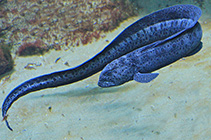| Family: |
Anarhichadidae (Wolffishes) |
| Max. size: |
240 cm TL (male/unsexed); max.weight: 18 kg |
| Environment: |
demersal; marine; depth range 1 - 226 m |
| Distribution: |
North Pacific: Sea of Okhotsk and the Sea of Japan to the Krenitzen Islands, in the Aleutian chain and Imperial Beach, southern California, USA. |
| Diagnosis: |
Anal spines: 0-0; Anal soft rays: 200. Dorsal with 228-250 spines. Caudal small. Anal with up to 233 rays. |
| Biology: |
Adults seek shelter among rocks in subtidal areas (Ref. 2850) and will occupy the same shelter until driven out by larger wolf-eels or a large octopus (Ref. 28499). Juveniles are pelagic for up to two years (Ref. 28499). Feed on hard-shelled invertebrates and fishes (Ref. 2850). Both male and female wrap their body around the egg mass to keep the eggs in place and to deter predators (Ref. 58332). Large specimens can inflict a painful bite (Ref. 28499). Its flesh is tasty (Ref. 28499). |
| IUCN Red List Status: |
Least Concern (LC); Date assessed: 14 December 2020 Ref. (130435)
|
| Threat to humans: |
traumatogenic |
Source and more info: www.fishbase.org. For personal, classroom, and other internal use only. Not for publication.

